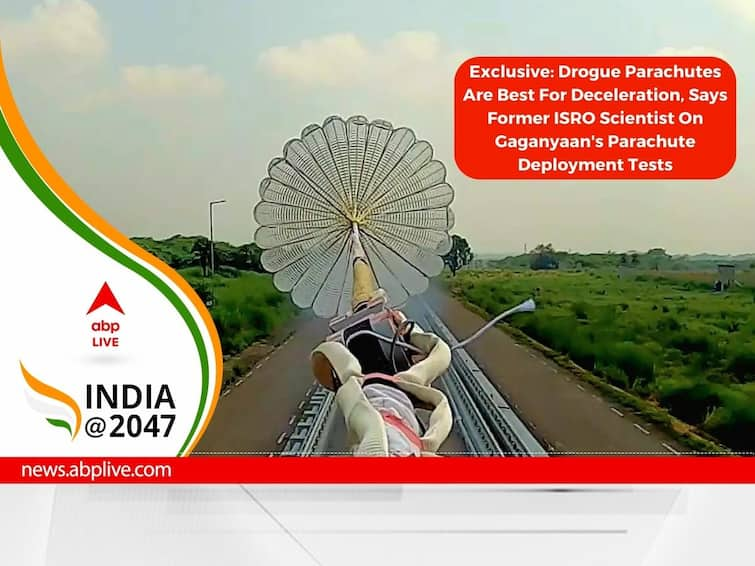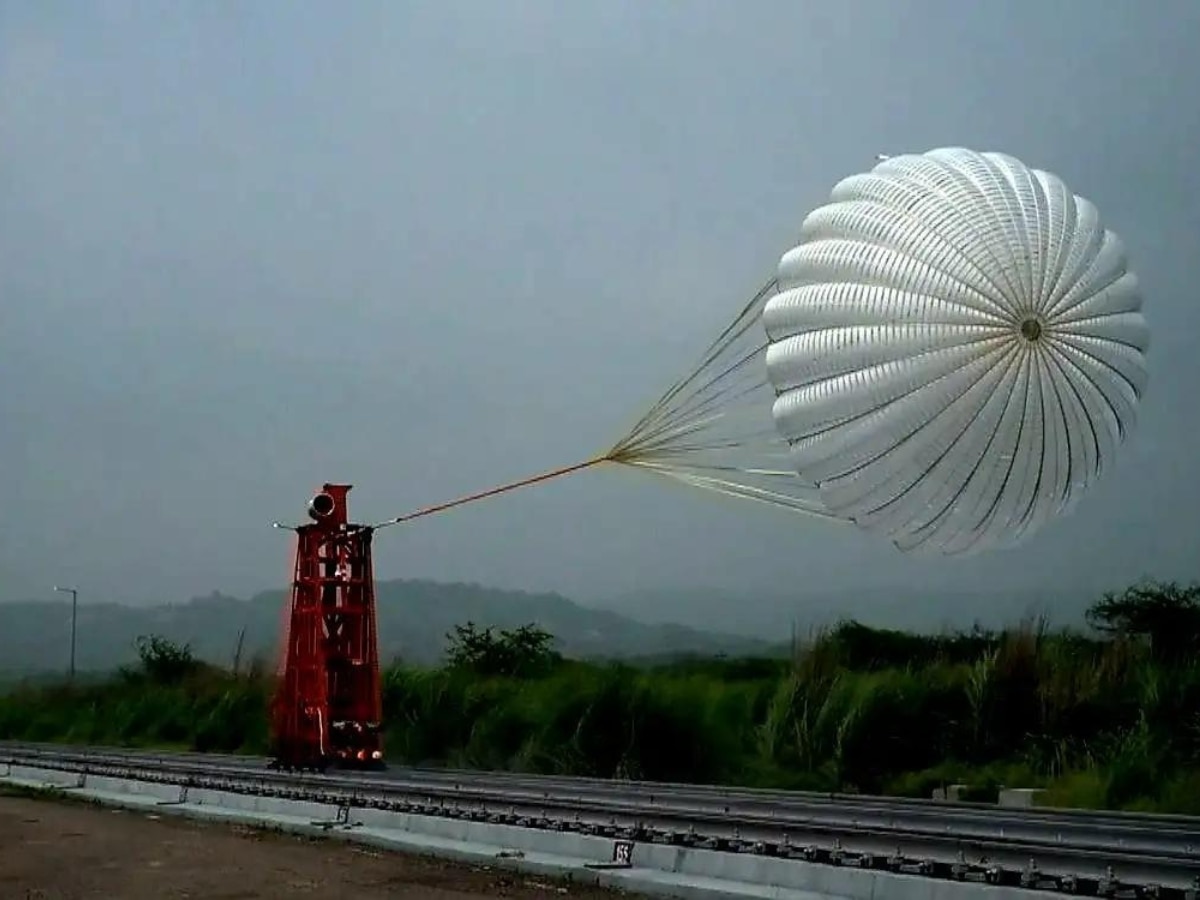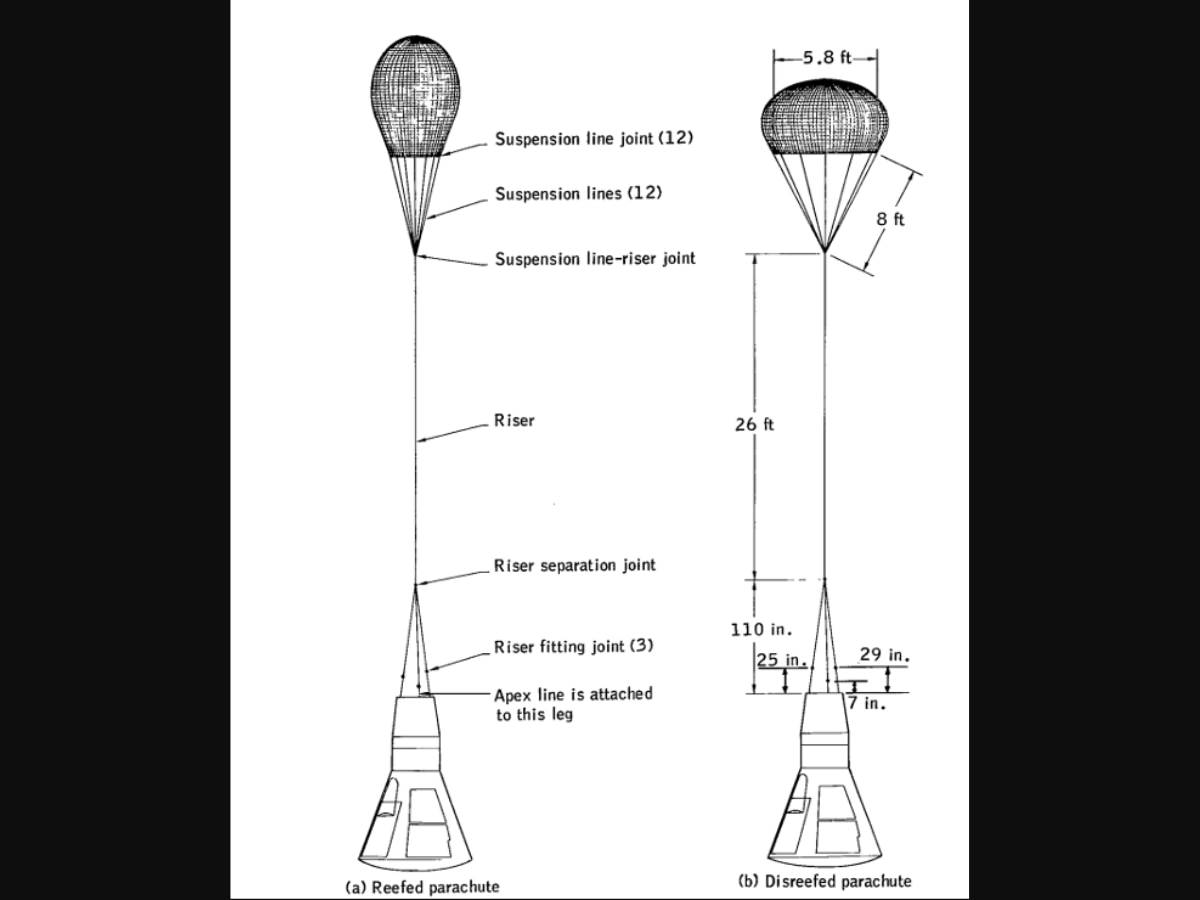Exclusive: Drogue Parachutes Are Best For Deceleration, Says Former ISRO Scientist On Gaganyaan's Parachute Deployment Tests
Gaganyaan parachute tests: Drogue parachutes have a smaller surface area than other parachutes in order to reduce drag, and hence, are best for deceleration, a former ISRO scientist told ABP Live.

Gaganyaan Drogue Parachute Test: The Indian Space Research Organisation (ISRO) has successfully performed a series of three drogue parachute deployment tests for the Gaganyaan mission. The tests were conducted by the Vikram Sarabhai Space Center (VSSC), ISRO, at the rail track rocket sled facility of the Terminal Ballistics Research Laboratory in Chandigarh, from August 8 to 10, 2023. ISRO conducted the tests in collaboration with Serial Delivery Research and Development Establishment (ADRDE), Defence Research and Development Organisation (DRDO).
Complex testing methods such as those performed at the rail track rocket sled are meant to test the performance of the small parachutes of the Gaganyaan programme. A rocket sled is a test platform that slides along a set of rails, propelled by rockets, and provides a controlled environment for high-velocity impact, aerodynamic and acceleration tests for articles such as payloads, aircraft and missiles, among others.
Mission Gaganyaan:
— ISRO (@isro) August 12, 2023
🔸VSSC/ISRO, in collaboration with ADRDE/ @DRDO_India , successfully conducted Drogue Parachute Deployment Tests at the RTRS facility in Chandigarh.
🔸Drogue parachutes, armed with pyro-based mortars, stabilize and decelerate the crew module during re-entry… pic.twitter.com/q9AN3jAxYN
Gaganyaan: How the drogue parachute tests were conducted, and what a former ISRO scientist says
Drogue parachute deployment tests are important because these help determine whether the drogue parachutes are functioning properly. Drogue parachutes play an important role in stabilising the crew module and reducing its velocity to a safe level before atmospheric re-entry, and have been designed in a way such that they will be ejected into the air upon command.
ABP Live spoke to Manish Purohit, a former ISRO scientist who played a pivotal role in the Chandrayaan-2 and Mangalyaan missions, and is an expert in spacecraft solar panel technology, and asked him about the significance of the ISRO drogue test, and other technical details.
Drogue parachutes consist of pyro-based devices known as mortars. These devices have pyrotechnic cartridges, which contain explosive substances and are intended to perform an initiation.
Drogue parachutes are placed inside deployment bags, which are stored in mortar tubes. The mortar tubes have an assembly containing pyrotechnic cartridges. These cartridges can be activated electrically to facilitate the ejection of drogue parachutes.
“The deployment of drogue parachutes involves their placement within deployment bags, which are subsequently stored in mortar tubes. These mortar tubes are equipped with an assembly containing pyrotechnic cartridges that can be activated electrically. This activation process facilitates the ejection of the drogue parachutes,” Purohit explained.

Drogue parachutes have a smaller surface area than conventional parachutes in order to reduce air drag, and hence, are best for deceleration, Purohit said. "The fact that drogue parachutes have a smaller surface area than conventional parachutes makes drogue parachutes suitable for deceleration purposes. This characteristic allows drogue parachutes to be deployed effectively at speeds that would otherwise cause damage to larger parachutes."
Drogue parachutes are separated using a cutter assembly, Purohit explained. The cutter assembly consists of a guillotine mechanism that can be initiated pyrotechnically to cut the line of the drogue parachute. Inside the cutter assembly, there is a housing that consists of a steel blade, a piston retainer, an anvil, and shear pins, Purohit said.
Two Standard Initiator cartridges are initiated to produce a rapidly expanding gas. This expanding gas shears the shear pins through the output pressure, causing the blade to properly forward. The blade moves approximately 1.5 centimetres forward, and severs the cable bundle, Purohit explained. After this, the blade penetrates into the steel anvil located behind the parachute line.
ALSO READ | Explained: What Is Luna 25? Roscosmos Mission That May Become First Spacecraft To Land On Moon's South Pole
“Typically, to facilitate the separation of drogue chutes, a cutter assembly is employed. This cutter assembly employs a pyrotechnically initiated guillotine mechanism to sever the line of the drogue parachute. Typically, this cutter assembly comprises a housing that incorporates a steel blade, piston retainer, anvil, and shear pins. The initiation of two Standard Initiator cartridges produces a rapidly expanding gas that propels the blade forward by shearing the shear pins through the output pressure. This action propels the blade approximately 1.5 centimetres forward, allowing it to sever the cable bundle before penetrating into the steel anvil located behind the parachute line,” Purohit said.
Gaganyaan's drogue parachutes are conical ribbon-type parachutes, have a diameter of 5.8 metres, and use a single-stage reefing mechanism. Reefing mechanism is a technique that helps regulate the deployment of parachutes.
"The term 'reefing mechanism' refers to a technique used to regulate the deployment of parachutes. The concept of reefing mechanism is similar to the folding mechanisms employed in sails on boats to manage surface area and resultant force during high winds. In the context of parachutes, the mechanism is used to control the deceleration by governing the rate at which the parachute opens," Purohit explained.
MUST READ | There Could Be New Particles, We Need To Have An All-Encompassing Theory: CERN Scientist Archana Sharma
A single-stage reefing mechanism is a technique in which the drogue parachute is deployed in a single step.
“In particular, ISRO employs a ‘single-stage reefing mechanism’ in their drogue parachute system. This mechanism streamlines the deployment process by enabling the complete drogue parachute to be deployed in a single step,” Purohit said.
NASA's reefing mechanism for crew re-entry drogue parachutes has a design which allows the reefing lines to be suspended at a specific altitude to ensure a controlled and gradual deployment of the parachute, Purohit explained. "This approach effectively manages the forces encountered during descent, contributing to increased safety and stability during re-entry operations."

A reefing mechanism does not allow the parachute to be deployed completely, while a disreefing process is one in which the parachute is completely unfurled.
According to ISRO, the single-stage reefing mechanism allows the drogue parachutes to minimise canopy area and mitigate opening shock. This ensures a smooth and controlled descent.
EXCLUSIVE On ABP Live | Space-Based Internet, International Collaborations — New Opportunities For India In Space Sector, And What Experts Say
ISRO also simulated real-world scenarios during the drogue parachute deployment tests to meticulously evaluate the performance and reliability of the drogue parachutes.
As part of the first test, ISRO simulated the maximum reef load, and during the second test, the space agency simulated the maximum disreefed load. The simulation of maximum reefed load is a milestone because it marks the introduction of reefing in a parachute deployed using mortars in India.
A reefed parachute is engineered in such a way that it can endure a deployment dynamic pressure of about 120 pounds per square foot, when located at an altitude of 50,000 feet, Purohit explained. This is called maximum reefed load.
"A circumstance in which a reefed parachute is required to endure a deployment dynamic pressure of about 120 pounds per square foot, at an altitude of 50,000 feet, arises when the crew module makes supersonic re-entry," Purohit said.
Supersonic re-entry refers to atmospheric re-entry made at speeds greater than the speed of sound.
Meanwhile, maximum disreefed load is the highest force that the parachute must endure when it is fully deployed, but not in a reefed state, Purohit explained. "This load is typically encountered during the descent phase when the parachute is fully opened, and is experiencing the full impact of the dynamic pressure from the surrounding air."
The third drogue deployment test demonstrated the deployment of the drogue parachute under conditions that emulated the maximum angle of attack that will be experienced by the crew module during its mission. In aviation, the angle of attack refers to the angle between the relative wind and a reference line on the aircraft.
MUST READ | EXCLUSIVE: India Has A Very Long Tradition Of Particle Physics, Says CERN Physicist Archana Sharma
Gaganyaan: The significance of drogue parachute tests
The drogue parachute deployment tests are significant because they helped confirm the readiness of the drogue parachutes for integration into the upcoming "Test Vehicle-D1 mission".
Explaining the significance of drogue parachutes for the Gaganyaan mission, Purohit said: “When the crew module enters Earth's atmosphere, it needs to slow down significantly. However, the speed at which it is moving is so high that regular parachutes could be torn apart by the air pressure. Special drogue parachutes are designed for this purpose.”
Purohit also said that drogue parachutes have a unique conical shape to allow them to handle intense air pressure. He explained that drogue parachutes effectively decelerate the crew module without causing any sudden jolts. “The way drogue parachutes are launched involves a pyrotechnic method, which means we use controlled explosives and an electrical signal to deploy the parachute. But at the moment of deployment, the parachute does not immediately open up fully.”
Purohit explained that the reefing mechanism keeps the drogue parachute partially closed, which is crucial because this is when the air pressure is at its highest, and the parachute needs to handle that stress before fully opening up. “Once this phase is handled, the disreefing process begins, which is essentially when the parachute fully unfurls.”
ALSO READ | What Are Dark Matter And Dark Energy? Here's What A CERN Scientist Says
During the ISRO tests, different scenarios were simulated. The maximum possible load was experienced during both the reefing and disreefing phases.
“About sixteen seconds after the drogue parachute is launched, two reefing line cutters are activated to sever the reefing lines. Once this is done, the drogue parachute stabilises the re-entry module until the main parachute is ready to be deployed,” Purohit explained.
The parachute system for the Gaganyaan crew module consists of 10 parachutes. During the descent of Gaganyaan astronauts towards Earth in the future, two apex cover separation parachutes will be deployed in the initial stage. These parachutes serve as protection covers for the crew module parachute deployment. After this, two drogue parachutes will be deployed to stabilise the descent and bring down the velocity of the astronauts. This is the stabilisation phase.
MUST READ | Why Did Eastern Parts Of India Receive Less Rainfall Than Other Regions This Year? Experts Give Reasons
After the release of the drogue parachutes, three pilot chutes will be used to extract three main parachutes individually. This will help reduce the speed of the Gaganyaan crew module to safe levels before landing. Of the three main parachutes, two are sufficient to land the astronauts on Earth. The third parachute is redundant. This is the extraction phase, and is important because the steps will reduce the crew module’s speed to safe levels to ensure a secure landing.
Earlier this year, ISRO conducted tests of the pilot and Apex cover separation parachutes. All these tests were successful, proving to be important milestones for Gaganyaan's parachute system development.
ALSO READ | Oppenheimer: The Manhattan Project, And How It Developed The Atomic Bomb
The Gaganyaan programme aims to demonstrate indigenous capability to undertake human spaceflight missions to low-Earth orbit. Three flights will be sent to low-Earth orbit as part of the Gaganyaan programme, which include two unmanned flights and one human spaceflight. The objectives of the uncrewed missions are technology demonstration, safety and reliability verification. The uncrewed missions are aimed at studying the spacecraft systems before conducting the first crewed spaceflight. Gaganyaan-1, the first instalment of the Gaganyaan programme, is expected to be launched in the first quarter of 2024.







































